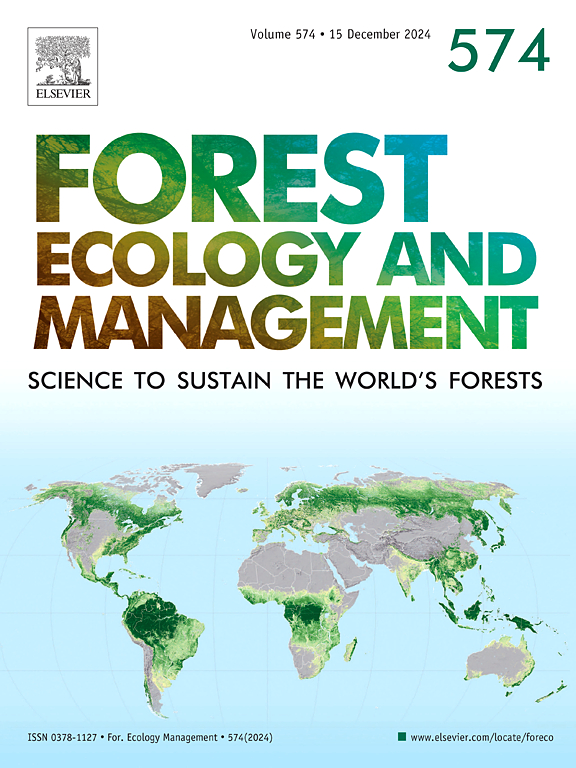对巴西半落叶季节性森林大树健康的影响
IF 3.7
2区 农林科学
Q1 FORESTRY
引用次数: 0
摘要
大树(lt);直径≥50 cm)具有独特的生态作用。它们对维持森林碳储量、水文制度、养分循环有重要贡献,也是野生动物的重要资源来源。山地居民更容易受到森林破碎化的影响,死亡率大幅上升。因此,调查这些个体的健康状况对于预测和预防潜在的崩溃非常重要。在本研究中,我们调查了不同大小(34-690 ha)森林碎片中LTs的健康状况和干扰历史。该分析是在位于巴西帕拉纳本文章由计算机程序翻译,如有差异,请以英文原文为准。
Impacts on the health of large trees in Brazilian semi-deciduous seasonal forest
Large trees (LTs; diameter ≥ 50 cm) play unique ecological roles. They significantly contribute to the maintenance of forest carbon stocks, hydrological regime, nutrient cycling, and are important sources of resources for wildlife. LTs exhibit increased vulnerability to forest fragmentation, with a considerable rise in mortality rates. Therefore, investigating the health status of these individuals is important for forecasting and preventing potential collapses. In this study, we investigate the health of LTs in forest fragments of different sizes (34–690 ha) and disturbance history. The analyses were conducted in permanent plots located in six fragments of the Semi-Deciduous Seasonal Atlantic Forest in northern Paraná State, Brazil. Trees were assessed using 11 health indicators condensed into a Health Threat Index (HTI). Out of the 62 trees assessed, 60 showed signs of health threats, with the most frequent indicators being the presence of lianas tangled in the crowns and stems, as well as partial crown death. Furthermore, a trend of reduced health in LTs was observed in smaller fragments. However, this pattern may also reflect differences in disturbance history, such as selective logging, which likely increases liana colonization. Our results highlight the importance of preserving large and well-conserved forest fragments for maintaining LTs health while emphasizing the need to account for additional factors, such as forest management practices. Therefore, the preservation of large mature forest fragments, along with monitoring and implementing effective management strategies for LTs, is of utmost importance for maintaining the structure and functioning of forest ecosystems.
求助全文
通过发布文献求助,成功后即可免费获取论文全文。
去求助
来源期刊

Forest Ecology and Management
农林科学-林学
CiteScore
7.50
自引率
10.80%
发文量
665
审稿时长
39 days
期刊介绍:
Forest Ecology and Management publishes scientific articles linking forest ecology with forest management, focusing on the application of biological, ecological and social knowledge to the management and conservation of plantations and natural forests. The scope of the journal includes all forest ecosystems of the world.
A peer-review process ensures the quality and international interest of the manuscripts accepted for publication. The journal encourages communication between scientists in disparate fields who share a common interest in ecology and forest management, bridging the gap between research workers and forest managers.
We encourage submission of papers that will have the strongest interest and value to the Journal''s international readership. Some key features of papers with strong interest include:
1. Clear connections between the ecology and management of forests;
2. Novel ideas or approaches to important challenges in forest ecology and management;
3. Studies that address a population of interest beyond the scale of single research sites, Three key points in the design of forest experiments, Forest Ecology and Management 255 (2008) 2022-2023);
4. Review Articles on timely, important topics. Authors are welcome to contact one of the editors to discuss the suitability of a potential review manuscript.
The Journal encourages proposals for special issues examining important areas of forest ecology and management. Potential guest editors should contact any of the Editors to begin discussions about topics, potential papers, and other details.
 求助内容:
求助内容: 应助结果提醒方式:
应助结果提醒方式:


